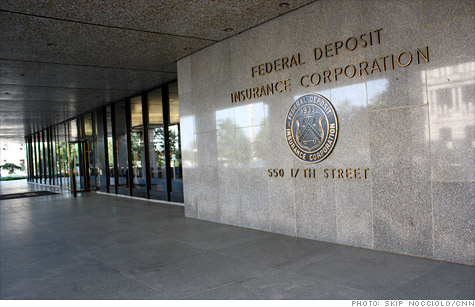Search News

The FDIC list of problem banks continued to shrink in the third quarter.
NEW YORK (CNNMoney) -- The number of banks at risk of failing fell in the third quarter, marking the second straight quarterly decline, according to a government report issued Tuesday.
Banks deemed troubled by the Federal Deposit Insurance Corp. dropped by 21 to 844, the agency said in its quarterly survey of the nation's banks. The FDIC's so-called problem bank list is comprised of the institutions considered most likely to fail, though few actually reach that point.
Only 26 of the nation's 7,436 banks failed in the quarter, 15 fewer than last year. And so far this year, only 90 banks have failed, compared with 149 at this time in 2010.
"The trend has been improving, but the current number of failures and problem institutions remains high by historical standards," said Martin Gruenberg, acting director of the FDIC.
Gruenberg was nominated in July to succeed Shelia Bair but has not yet been confirmed by the Senate.
The FDIC's report also showed that the banking sector generated the highest profit levels since the second quarter of 2007 -- before the financial crisis. The report said that 14.3% of institutions reported a net loss during the third quarter, the smallest proportion since first quarter 2008.
Banks earned nearly $35.3 billion in the third quarter, according to the FDIC, up from $23.8 billion from the same quarter last year.
Some of those increases stemmed from an accounting quirk that allowed banks to book declines on the price of their debt as revenue.
Much of the drop in the price of debt at U.S. banks has been caused by investor fear over the exposure of certain banks to sovereign debt in Europe. The lower priced debt essentially means that investors aren't willing to pay more because they deem the banks to be less credit-worthy.
Absent this accounting provision used by "a few large banks," the FDIC said net operating revenue would have decreased from the third quarter 2010. That means that the latest quarter would have marked the third straight decline.
Shares of JPMorgan Chase (JPM, Fortune 500) and Wells Fargo (WFC, Fortune 500) have dropped 29% and 22% respectively this year.
Meanwhile, Citigroup (C, Fortune 500) and Bank of America (BAC, Fortune 500) have inked even sharper stock plunges of 47% and 59% so far this year.
Throughout the press conference following the report's release, acting director Gruenberg tried to assuage concerns about U.S. banks' exposure to contagion from Europe's debt crisis. Still, he admitted that he couldn't adequately assess exactly how much exposure U.S. banks had to contagion from Europe's debt crisis.
"It's the nature of a contagion. You can't estimate the impact it will have on the markets," said Gruenberg. "That is probably the focus of our greatest attention from the standpoint of the stability of the U.S. financial system
The FDIC's report did offer some positive signs, notably that the United States may be a less delinquent population. Third-quarter net charge offs or the banks' estimates of its uncollectable debts, decreased 39% to $26.7 billion from the same period last year, the lowest total since the second quarter of 2008.
Banks' reports of loans and leases that were 90 days past due also dropped by $10.5 billion, or 3.3%, from the second quarter. That marks the sixth straight quarterly drop of 90-day delinquent loans.
At the end of September, the insurance fund had a positive balance of $7.8 billion, up $3.9 billion from the second quarter. The insurance fund had a deficit of nearly $21 billion at the end of 2009 after a wave of bank failures drained its reserves.
As problem banks fell, the size of the U.S. financial sector also continued to shrink. There are now 7,436 banks in the United States, down from 7,513 at the end of the second quarter.
In addition to bank failures, 49 banks merged with existing institutions, and no new banks were granted charters by the FDIC. ![]()
| Index | Last | Change | % Change |
|---|---|---|---|
| Dow | 32,627.97 | -234.33 | -0.71% |
| Nasdaq | 13,215.24 | 99.07 | 0.76% |
| S&P 500 | 3,913.10 | -2.36 | -0.06% |
| Treasuries | 1.73 | 0.00 | 0.12% |
| Company | Price | Change | % Change |
|---|---|---|---|
| Ford Motor Co | 8.29 | 0.05 | 0.61% |
| Advanced Micro Devic... | 54.59 | 0.70 | 1.30% |
| Cisco Systems Inc | 47.49 | -2.44 | -4.89% |
| General Electric Co | 13.00 | -0.16 | -1.22% |
| Kraft Heinz Co | 27.84 | -2.20 | -7.32% |
| Overnight Avg Rate | Latest | Change | Last Week |
|---|---|---|---|
| 30 yr fixed | 3.80% | 3.88% | |
| 15 yr fixed | 3.20% | 3.23% | |
| 5/1 ARM | 3.84% | 3.88% | |
| 30 yr refi | 3.82% | 3.93% | |
| 15 yr refi | 3.20% | 3.23% |
Today's featured rates: